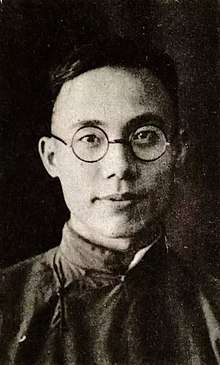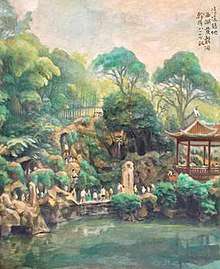Fang Ganmin
| Fang Ganmin | |
|---|---|
 Fang Ganmin, c. 1930 | |
| Native name | 方幹民 |
| Born |
15 February 1906 Wenling, Zhejiang, China |
| Died |
21 January 1984 (aged 77) Suzhou |
| Nationality | Chinese |
| Known for | Painting, drawing, sculpture |
| Movement | Cubism, Chinese Modernism |
| Spouse(s) | Su Ailan(蘇愛蘭) |
| Fang Ganmin | |||||||
| Traditional Chinese | 方幹民 | ||||||
|---|---|---|---|---|---|---|---|
| Simplified Chinese | 方干民 | ||||||
| |||||||
Fang Ganmin (simplified Chinese: 方干民; traditional Chinese: 方幹民; 15 February 1906 - January 1984) was a Chinese French-trained cubist painter, sculptor and educator, who was educated in Paris and spent most of his adult life in China. Regarded as one of the fathers of Chinese oil painting, Fang was born in the Wenling county, Zhejiang province. He began studying painting in 1924 and went to Paris in 1925, enrolling in the L'Ecole Superieure Nationale des Beaux Arts, making him, along with Xu Beihong and Sanyu, one of the first Chinese painters to study abroad in France. Upon returning to China, he assisted in founding and taught at the National Arts Academy, Hangzhou, becoming a professor at the Western Painting Department.[1][2] During the Cultural Revolution, Fang was shamed and tortured by the Red Guards, and most of his work was destroyed. He died in 1984. His students include Zao Wou-Ki, Chu Teh-Chun[3] and Wu Guanzhong.[4]

Timeline
In 1906, Fang Ganmin was born in Wenling, Zhejiang on February 15th. His father, Fang Yue (also known as Xun Cheng), was an official. literary degree holder, who majored in the study of written characters and published several books including "A Simple Approach to The Study of The Six Classes of Characters".
In 1920, Fang attended Andin High School in Hangzhou, gradually showing his talent in art.
In 1924, he went to Shanghai in the summer to apply for the Shanghai Academy of Fine Arts and was accepted to the second level where he was educated with a solid drawing foundation under the direction of Russian teacher V. Podgursky.
In 1925, he left Shanghai for France to further his studies.
In 1926, after leaning French at a town outside Paris for six months, Fang was accepted into an art school in Lyon where he took "Paster Casts" and "Future drawing" classes.
In 1927, Fang attended L'Ecole des Beaux de Paris and joined Jean Paul Laurens' studio, together with Yan Wenliang. Apart from taking drawing lessons at the studio, he was also a frequent visitor to galleries and museums and developed a strong interest in post-impressionism.
In 1929, he married Ms. Ai Lan Su in Paris. He returned to China in the winter, and was hired by the Shanghai Private Xin Hua Fine Arts Academy, but later transferred to Shanghai Fine Arts University and Shanghai Academy of Fine Arts.
Career
Fang Ganmin studied in Shanghai Meizhuan and under Jean-Pierre Laurens (1875–1932), son of Jean-Paul Laurens (1838 – 1921), at the L'Ecole Superieure Nationale des Beaux Arts, Paris from 1926 to 1929, together with Chinese artists such as Yan Wenliang. He taught in Xinhua AFA, Shanghai, and Hangzhou Academy.[5]
In 1951 and 1952, a campaign against modernist art, condemned in Soviet terms as both bourgeois and formalist, had forced Lin Fengmian and Wu Dayu to leave the art academy in Hangzhou and return to Shanghai. Realism was deemed the progressive style. Fang Ganmin managed to remain, but was nonetheless marginalised and condemned for his modern styles.[6]
During the Cultural Revolution, Fang, branded a anti-revoluntary for his modernist artistic style, was paraded around the National Academy of Art in Hangzhou, ink and paint poured over him as students beat and denounced him. Fang was also imprisoned by the Red Guards for long periods.[7]
Works

Of Fang’s early paintings, two are particularly noteworthy. They are exercises in the Cubist manner, and give to their subject, both nudes, the geometrical and sculptural, but not the fragmented, effect of a picture by Braque. One of them is ''Melody in Autumn'' (1934). The other is "White Doves" (1932), which portrays geometric shapes suggestive of Cubism, but with a Art Deco-like structural undertone.
In jest, his students called his style fang (‘square’), punning on his surname Fang, which also happens to be one of the characters of the Chinese word for ‘cubic’.[8]
Notable students
- Chu Teh-chun
- Wu Guanzhong
- Luo Gongliu
- Zao Wou-ki
- Min Xiwen
References
- ↑ von Sarah Khan (27 March 2009). Globalisierende Kunstmärkte: Das Phänomen Kunst im 21. Jahrhundert aus globaler Perspektive. Zum Ende des hegemonialen Anspruchs des westlichen Kunstsystems und zum Anfang einer post-globalen Kultur. LIT VERLAG. pp. 113, 115, 116.
- ↑ Sullivan, Michael (1998). Art and Artists of Twentieth-century China. University of California Press. pp. 40, 301.
- ↑ "水天中:朱德群和他的画_画廊新闻_雅昌新闻". news.artron.net. Retrieved 2018-02-02.
- ↑ Yasuko FURUICHI, 古市保子 (2006). Cubism in Asia: Unbounded Dialogues -- Report. Japan Foundation (Tokyo, Japan). pp. Presentation 2 of Session 1, Presentation 1 of Session 3.
- ↑ Sullivan, Michael (2006). Modern Chinese Artists: A Biographical Dictionary. University of California Press. p. 86.
- ↑ Julia F. Andrews, Kuiyi Shen (2002). The Art of Modern China. University of California Press. pp. 62, 70, 142.
- ↑ "From Republican-Era Shanghai to Postwar Paris: Pan Yuliang's Bold Portraits". frieze.com. Retrieved 2018-09-24.
- ↑ Pan, Lynn (2008). Shanghai Style:Art and Design Between the Wars. Hong Kong: Joint Publishing Hong Kong. p. 74.